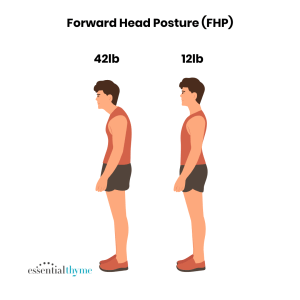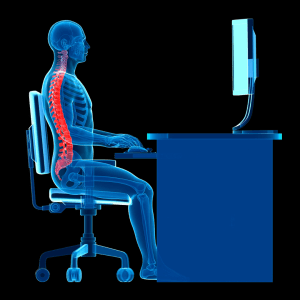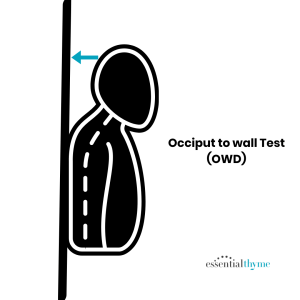How much does your head weigh?
Have you ever thought about how much your head weighs?
An average head when standing in a neutral postural position is around 12lb. However, this can increase if you have incorrect posture.
Posture can be described as how your spine is aligned with your head, shoulders, and hips.
Whether you’re sitting or standing, posture is the position of your body. Have you ever noticed pain in your neck, upper back, or shoulders? This could all be down to posture and how your body is aligned daily.
There’s no such thing as ‘perfect posture’ as each body is different. However, ‘good’ posture refers to a neutral spine in which your muscle groups, joints, and ligaments are aligned in a way that reduces stress on them.
If you frequently game or text, it’s likely your head is further forward. This could be attributed to spending a lot of time looking down and bending your head downwards. As a result, this places extra pressure and strain on the your neck. For each 2-3cm your head slips forward the load doubles on your neck and shoulders.

The effects of poor posture
Forward Head Posture (FHP) can lead to a painful shortening of the back of the neck muscles. It can also be accompanied by compression of the cervical vertebrae. This is the uppermost portion of the spine that supports the head and protects the spinal cord.
Not only can poor posture affect how you look, but it also comes alongside a set of other issues.
Other problems associated with FHP are as follows:
- Headaches
- Neck discomfort
- Muscle tension in your neck and shoulders
- Discomfort in the mid back
- Chest pain
- Pins and needles, and numbness in your arms and hands
Long-term side effects could include:
- Reduced shoulder mobility
- Osteoporosis
- Cervical spine arthritis
- Bulging discs
Furthermore, another result from FHP is that of loss of vital lung capacity up to 30% reduction.
What can you do to improve your posture?
Fortunately, there are many ways in which you can improve your neck posture yourself.
Alongside making necessary lifestyle adjustments to optimise posture, you can stretch tight muscles. Additionally, you can strengthen weak muscles that are preventing you from maintaining a good posture.
The first step to improving posture is taking note of your posture throughout the day. You could do this by setting a timer every half an hour or so. If your neck is facing downward when the timer goes off, pull it back into a neutral position.
If you work a desk job, you can consider a more ergonomic chair with a headrest. Keeping your head against the headrest will prevent it from moving forward and in turn will improve your posture.

A few simple stretches that could help your neck posture include:
- Neck extension
- Flexion of the neck
- Neck side flexion
Simple exercises that could help your head posture include:
- Chin tucks
- Look left, look right
Another test you can try at home to measure FHP is called the Occiput to Wall Distance Test (OWD)
How to measure your OWD:

Stand against a wall, with your feet together heels, calves, buttocks, and shoulders touching the wall and stand as straight as possible. Also try to have the back of your head also touching the wall without forcing it backwards and keep facing forward.
If the occipital (base of skull) can touch the wall you then score zero – this means you have good posture.
If the occipital is not touching the wall, you would measure the distance between the wall and the Occipital. Measuring 2cm or more this is classed as abnormal. This means the weight and pressure on your neck; back & spine can be causing you other detrimental conditions in the body. You will need to work on correcting your posture to help get back into a neutral position.
How can massage help?
Poor posture can occur for many different reasons. The most common reasons include work, gaming, excessive use of electronic devices, and exercise. Poor posture can result in muscle tightness, joint stiffness, and an increase in pain.
Various types of massage can be used to assist in approving posture. The most common include:
- Deep tissue massage
- Sports massage
- Swedish massage
A wide variety of techniques can be used to help improve posture. The techniques most used are:
- Deep strokes
- Mobilisations
- Myofascial release
Massage could help to improve posture in terms of acute pain, relaxation, or tight muscles.
Are you suffering from neck or upper back pain due to a ‘bad’ posture?
Here at Essential Thyme, we deliver bespoke massage tailored to target the pain and help to release any tension.
Visit our website for more information or to book your massage today!
Alternatively, are you in the early stages of massage therapy and looking to learn?
We are a fully accredited training school offering the following training courses:
- Swedish
- Indian Head
- Thai hand and Foot
- Cupping
- Essential Oils Safety, Blending & Uses Level 1 & Level 2
